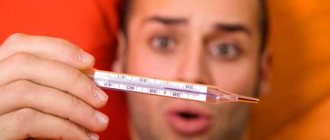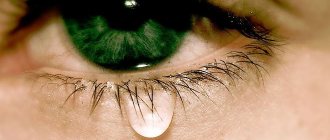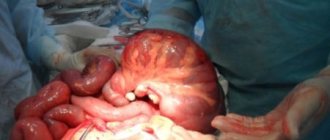05/11/2019 Category: Chemical poisoning
If a person has a temperature of 36, what does this mean? To answer this question, you need to find out what kind of indicator this is, because you need to know as much as possible about everything that is normal for a person. A complex process of interaction between various organs and tissues, intracellular energy reactions create a strictly defined thermal background in the body of warm-blooded animals - birds and mammals, including humans.
The concept of "body temperature"
Animals that are able to retain their body heat within narrow limits, regardless of environmental conditions, are called warm-blooded (homeothermic). These include mammals and birds. Animals deprived of this ability are usually called cold-blooded (poikilothermic). The process of maintaining temperature is called thermoregulation.
Cold-blooded animals have an unstable body temperature, which is most often close to the external environmental parameter. Warm-blooded animals, which include humans, have a practically unchanged indicator. The highest value was observed in birds. It varies between 40-41°C. Mammals “warm up” to 32-39°C, depending on the species. In humans, values within 36-37°C are considered normal.
Normal body temperature
What does a temperature of 36.2°C mean? The latter showed that the norm fluctuates between 36.2-37.5°C. Well, if the temperature is 36.0°C, is this considered normal? You should know that this indicator often differs among different ethnic groups of people. For example, the Japanese standard is only 36°C. For residents of Australia and America, the average reaches 37°C.
It is also important to know that different parts of the human body have different temperatures. For example, in the armpits it is higher than in the neck and face. Also on the skin of the feet and hands, and the lowest on the toes. There are 2 types of temperature: internal organs and skin. Organs have different temperatures, which depend on the activity of ongoing processes. The temperature of internal organs, as a rule, exceeds the temperature of the skin by an average of 0.3-0.4°C. The “hottest” liver is approximately 39°C.
Using your toes, you can determine the speed of metabolic processes in the body. If a person has warm lower extremities, then he has a high rate of metabolic reactions, if cold, it means he has a low rate.
Diagnostics
Thermometry is performed with an electronic, infrared non-contact, or less often a mercury thermometer. The first one must be held until the sound signal. The second one is enough to bring to the forehead for one second. The third is first shaken so that the mercury drops below 35º and held for 5-10 minutes. Contact devices can be used:
- in the armpit, which is previously wiped from sweat,
- in the mouth,
- in the rectum in a lateral position with legs bent
If hypothermia is suspected (the patient's appearance, complaints, in a serious condition - the circumstances under which it was discovered), thermometry is performed in the intestinal lumen, esophagus with a thermometer with a probe. It is combined with measurements in the nasopharynx and a fresh portion of urine.
The catheter helps determine the temperature in the pulmonary artery. The ECG records changes in the form of a J wave after the ventricular complex. Blood tests monitor the levels of potassium, glucose, electrolytes, urea, creatinine, hematocrit, and coagulation parameters.
Note!
Monitoring of blood pressure and diuresis is mandatory. Pulse oximetry is performed to determine blood acidity.
They always check for sepsis and hypothyroidism. Medicines should be used with caution, as kidney function and metabolism are impaired. The risk of ventricular fibrillation requires careful transportation of patients. Arterial catheterization allows you to monitor blood gas composition and pressure. You need to remember about possible cerebral edema. The area and depth of soft tissue lesions are assessed separately.
How to measure temperature correctly?
Often a person feels unwell and has a temperature of 36. What does this mean? Usually the value is normal and should not cause suspicion. A person's temperature can fluctuate between 36-37 °C. However, a slight decrease and loss of strength, as a rule, indicate the presence of certain diseases.
It is very important to be able to measure temperature correctly. This can be done in several ways: in the mouth, in the armpit, in the rectum.
However, the results may vary slightly. The temperature in the mouth is usually 0.5 degrees lower than in the rectum, and the same amount higher than the temperature measured in the armpit.
What does a temperature of 36.9 mean? In Russia, the armpit is often used for measurement. It is noteworthy that this method is not very reliable, since with it a person receives inaccurate results. When measuring temperature in this way, the normal value is 36.3-36.9 ° C.
In European countries, oral measurement is common. This method is considered quite reliable. If, when measured by this method, the temperature is 36.8, what does this indicator mean? This value is normal, since when measuring the temperature in the mouth it can fluctuate between 36.8-37.3°C. However, you should know that this method is contraindicated for young children under 5 years of age, people with increased excitability and mental illness.
Rectal gives the most accurate result, since in the rectum the temperature is closer to the temperature of the organs. The norm in this case is 37.3-37.7°C.
Before the operation, the patient has a temperature of 36 - what does this mean? Artificially lowering the temperature in medicine is not uncommon: in this case it is lowered on purpose.
At temperatures above 42°C, human brain tissue is damaged. If it falls below 17-18°C, death will occur.
Normal temperature is a sign of good health
It is important to remember that a person’s temperature changes over the course of 24 hours. Measurements are influenced by factors such as time of day, environment, and even mood. It is necessary to measure the temperature at the same time for several days, it is desirable that the state of health at these moments is satisfactory.
Write down the results in your notebook. After 3-5 days, you can analyze the indicators and calculate the average value - this will be the norm.
There is no need to be alarmed if the thermometer shows numbers higher or lower than the usual 36.6°C. A slightly increased or decreased body temperature in an elderly person is an acceptable deviation. The normal range is considered to be from 35.8°C to 36.9°C. Anything that goes beyond the specified limits should cause alarm: this is a reason to immediately consult a doctor.
It is important to know
If the temperature is 36, what does this mean? Norm or deviation? For each person, this indicator varies during the day within the range of 35.5-37.0 ° C, and this is considered normal. It is lowest in the morning and reaches its maximum value in the evening.
Low body temperature (36 °C) falls within the acceptable range. But if it drops below 35°C, this indicates the presence of some serious disease. When the temperature drops to 32.2°C, the person falls into a stupor. At 29.5°C, a person will lose consciousness and die if it drops below 26.5°C.
Temperature can be affected by a person's age and gender. For example, in girls it stabilizes by the age of 13-14, and in boys by about 18. The average temperature in men is 0.5-0.7 ° C lower than in women.
When is hypothermia normal in children?
For different age groups of children, the reasons for low thermometer readings differ. How different are the methods for eliminating this condition. In many cases, hypothermia in children has the same causes as in adults, but sometimes it is triggered by specific factors.
In infants
In the first days of life, newborns sometimes have low temperatures. This is the so-called cold shock. The baby experienced stress at birth, and then found himself in new conditions. His thermoregulation system is still being adjusted, so in the first days, newborns’ normal readings are up to 35.6 degrees. The baby just needs to be well covered and kept warm.
Premature babies also have low body temperature. They need extra warmth until their own thermoregulation is adjusted.
During adolescence
A hormonal surge occurs, which sometimes affects the regulation of heat exchange in the teenager’s body. This is due to the fact that the hypothalamus, which is responsible for ensuring normal thermoregulation of the “core” (internal organs), also undergoes a hormonal surge and reacts to changes in such an unusual way.
Fever
What does a temperature of 36.9°C mean? Is this indicator a sign of illness? Typically, an increase above 37°C indicates some kind of disease. This symptom is quite common and can be observed with various ailments and diseases. A condition that does not subside for a long time is considered dangerous for humans. If you have an elevated temperature, you should definitely consult a doctor to find out the possible cause. If it reaches 41°C or higher, you should immediately call an ambulance.
Symptoms of hypothermia
The clinical picture will depend on the stage of hypothermia. The mild stage will be characterized by the following symptomatic complex:
- disturbance of orientation in space and time;
- apathetic state;
- drowsiness;
- rapid breathing;
- tachycardia;
- muscle tremors;
- impaired coordination of movements;
- low or high blood pressure.
The average form of hypothermia will be characterized by the following clinical picture:
- confusion;
- breathing and heart rhythm disturbances;
- trembling throughout the body;
- violation of movement coordination;
- slowing down metabolic processes;
- the presence of nausea and vomiting in a child and an adult;
- decreased mental activity.
At this stage of hypothermia, a person may still be conscious, but for a newborn this body temperature can be critical. This is especially dangerous during pregnancy.
Signs of hypothermia at the last stage are characterized as follows:
- there is no reaction of the pupils to light;
- no tendon reflexes;
- blood pressure decreases to critical levels;
- the amount of urine excreted increases;
- the frequency of respiratory movements is reduced to 8–10 per minute;
- symptoms of atrial fibrillation;
- severe bradycardia.
Symptoms of hypothermia
General hypothermia is extremely life-threatening: if a person is not provided with medical assistance in the next few minutes, there is a high probability of death.
What to do in case of high temperature?
The most important thing to do is see a doctor. You should start with an examination by a therapist. He will conduct an examination and prescribe a series of studies. During the visit, it is imperative to examine the lymph nodes.
Then you need to take a urine and blood test, do an ECG, an ultrasound of the kidneys and abdominal organs, kidneys, and be tested for dysbacteriosis.
Despite the fact that the human body cannot function normally at temperatures that are too low or too high, there are cases where a person managed to survive. Thus, according to information obtained from the Guinness Book of Records, the maximum temperature in history was recorded in 52-year-old Willie Jones, who was admitted to Grady Memorial Hospital on July 10, 1980. His body temperature was 46.5 ° C. The patient spent 24 days in the hospital, after which he was safely discharged.
The person with the lowest documented temperature was two-year-old Carly Kozolofsky, who accidentally spent 6 hours in the cold on February 23, 1994. After a long stay in the cold (-22°C), her body cooled to 14.2°C.
Patients in this condition practically do not go to doctors, so the condition has been poorly studied. Let's try to analyze some typical conditions in humans, in which the body temperature is lower than 36.6 degrees Celsius.
You should pay close attention to low body temperature, since under its cover dangerous diseases occur that pose a threat not only to human health, but also to human life. To thoroughly understand the mechanisms of its reduction, the process of thermoregulation should be studied.
Types of thermoregulation in the human body
- Physical thermoregulation is accompanied by heat retention due to vasodilation and sweating. With its help, the body adapts to temperature changes.
- Chemical thermoregulation is carried out due to the production of heat in the process of biochemical reactions. Due to this mechanism, a person survives even when exposed to low temperatures.
- Behavioral thermoregulation is an instinctive urge to seek more favorable temperature conditions.
Causes of hypothermia
There are many reasons for a decrease in body temperature, and some of them may be extremely short-term in nature and caused by random reasons. Hypothermia can be caused by certain medications, hypothermia, prolonged insomnia, prolonged hunger, general overstrain of the body, intoxication after large doses of alcohol, and so on.
Most often, the restoration of normal body temperature under such factors occurs immediately after the effect of the factor that caused it weakens and passes. In some cases, additional correction is necessary in order to quickly return him to normal health.
A decrease in body temperature to 35.7-35.8 degrees does not pose any danger, and ordinary insulation with clothing or hot tea followed by sleep can return the indicators to normal. In cases where this temperature persists for a long time, it is necessary to visit a specialist.
A low temperature within 35.3-35.5 degrees may indicate the presence of the following diseases:
- Venous insufficiency;
- Thyroid problems;
- Diabetes;
- Drug overdose;
- Adrenal problems;
- Hormonal imbalances;
- Iron deficiency in the body;
- Stomach ulcer;
- Kidney failure;
- Exhaustion of the body;
- Depressive states;
- Problems with the spine.
Stimulants for a drop in temperature may include the use of alcohol and drugs, a general loss of energy, and prolonged fasting, for example, dieting. Hormonal deficiency can seriously slow down metabolic processes, reduce the absorption of nutrients, and lead to disruptions of the endocrine system.
Pathologies of the cardiovascular system can also cause a decrease in temperature, which can lead to weakness and ischemia, which in turn leads to a decrease in body temperature to 35.2 degrees and below.
The body strives to balance its state, which in some cases is accompanied by a person’s irritability and aggressiveness, but can also lead to inhibition of actions and deterioration of the thought process.
Temperature is determined using a thermometer. Today there are two types of measuring instruments:
- Mercury. They are considered traditional and are placed under the arm for 5-7 minutes.
- Electronic. They independently signal the completion of measurements. If there is any doubt about their accuracy, it is necessary to re-measure.
In the process of measuring temperature, the main thing is to obtain correct results. In most cases, the thermometer is placed in the armpit. This measurement method is distinguished by the convenience of fixing a person, but from the point of view of the accuracy of the results obtained, it cannot be considered optimal.
Abroad, the main method of measurement is placing a thermometer in the mouth. In this case, high measurement accuracy is achieved, but there is a risk of seeing through or dropping the measuring device, especially with severe chills and a semi-conscious state of the patient. This measurement technique is not suitable for young children and patients with mental disorders.
For infants and comatose people, the main way to determine body temperature is to insert a thermometer into the rectum. In turn, the temperature inside the body will always be slightly higher than on its surface, which is worth taking into account when making corrections. In hypothermia, such measurement methods are not entirely suitable.
Etiology
Quite often people face the problem of lowering their body temperature. In this regard, they are interested in the question of why this happens and what causes it.
For humans, the optimal temperature is 36.6 degrees when measured in the armpit. This indicator can shift by 0.5 degrees. However, if the body temperature begins to decrease, and the difference is already 1–1.5 degrees, then this indicates the appearance of pathologies in the body.
The causes of abnormal cooling of the human body are interconnected with various factors. The indicator may decrease for the following reasons:
- immune system disorder;
- lack of vitamins;
- infectious diseases;
- operations;
- stressful situations;
- physical ailment.
A small or significant drop in temperature can also occur from hypothermia, poisoning with drugs or alcoholic beverages, as well as with a sharp change in blood pressure, development, and other ailments.
The manifestation can also be formed under the influence of other factors:
- time of day;
- person's age;
- exposure to environmental factors;
- pregnancy;
- individuality of the organism.
With the slightest changes in temperature and suspicious signs, a person should seek qualified medical help.
It is especially important to monitor the child’s condition, since children during the developmental period are quite vulnerable and sensitive to various disorders in the functioning of organs.
Symptoms of true hypothermia
True hypothermia has characteristic symptoms, causes and types, which must be paid attention to in order to exclude the development of serious complications and seek medical help in time.
Note!
Weakness and hypothermia are inextricably linked concepts. Therefore, if you are in a state of complete apathy, when any movement or word is difficult, immediately measure your body temperature.
Symptoms of hypothermia:
- The skin becomes pale and cold;
- Increased sweating, accompanied by chills;
- Blood pressure is low;
- Pulse rare;
- Dizziness;
- Prostration;
- Lethargy;
- Desire to sleep;
- Retardation of movements.
When the temperature becomes critically low (33-34 degrees), the symptoms worsen and the following signs appear:
- Severe chills;
- The skin becomes pale blue or gray in color;
- General lethargy accompanied by disturbances of consciousness;
- Thready pulse;
- Movements are limited;
- Speech is slurred;
- Hallucinations.
Critically low blood pressure results in fainting.
If, in parallel with these appearances, body temperature measurements confirm the presence of hypothermia, you should immediately call doctors.
With further drops to 32 degrees, death is possible.
Symptoms
Low temperature in a child and an adult has characteristic symptoms that indicate certain changes. If the reading is below 36 degrees, the patient experiences the following symptoms:
- weakness and malaise;
- drowsiness and fatigue;
- irritability.
If the patient’s body temperature is below 35 degrees, then the symptoms become more intense and the following are noted:
- trembling throughout the body;
- confused speech;
- heaviness throughout the body;
- skin of an ash-gray or blue hue;
- weak pulse;
- hallucinations;
- fainting.
If the reduced body temperature of a person reaches 32 degrees, then death occurs.
A low temperature accompanied by other signs will indicate the appearance of a disease in the body:
- general deteriorated condition;
- lethargy;
- shiver;
- cold skin;
- drowsiness;
- lethargy or irritability;
- decreased heart rate;
Quite often, women experience low temperatures during pregnancy. In this case, the expectant mother will experience additional symptoms:
- loss of appetite;
- vomiting attacks;
- chilliness in the lower extremities;
When hypothermia is a symptom of a chronic disease
The causes of low human body temperature may be hidden in the exacerbation of chronic diseases. A prolonged decrease should definitely alert you if you have the following symptoms:
- Constant feeling of cold, chills.
- Headache.
- Breathing problems.
- Cardiac dysfunction.
- Brittle hair and nails.
- Pale skin.
- Difficulty remembering.
- Confusion.
- Fatigue, general weakness.
A constantly low body temperature, supplemented by some of these symptoms, should be a reason to visit a therapist. In the future, a number of examinations will be required to establish a diagnosis and prescribe adequate treatment.
Low body temperature itself is not a disease, but it is a sign of another disease. Diseases that can cause hypothermia include:
Thyroid gland dysfunction. Here, a low temperature will occur against the background of slow mental processes, brittle hair and nails, and rapid fatigue. This condition is caused by a lack of the hormone TSH (thyroid). Treatment can only be prescribed by an endocrinologist.
Hormonal imbalances. They are typical not only for teenagers, but also for pregnant women and menopausal women. A decrease in body temperature is not always a reason for treatment. For examination and treatment, you will need to contact a therapist or gynecologist.
Chronic diseases in latent form. In some diseases, such as brain tumors, prolonged hypothermia is possible as one of the symptoms of the disease. The presence of specific symptoms at low body temperature can be caused by diseases of the adrenal glands, kidneys, liver, and internal bleeding. Hypothermia is also observed when blood pressure decreases.
Only a specialist with a narrow focus can determine the causes and prescribe treatment, but first you need to consult a therapist.
Skin diseases. The occurrence of skin diseases that affect large areas can provoke a decrease in temperature. Here it is caused by the fact that the blood must serve the affected areas, as a result of which the supply of other organs suffers.
Alcohol, drugs. Too large doses of ethyl alcohol in the body, drugs and a number of other poisonings, chronic alcoholism, drug addiction also cause a decrease in body temperature. It is especially dangerous to be intoxicated in the cold. This will provoke a faster decrease in temperature, which often leads to complications such as frostbite and damage to internal organs.
If, as a result of an exacerbation of a chronic disease, a low body temperature occurs, only a specialist can tell you what to do. Here you need not only a consultation, but also competent, long-term treatment.
Treatment
Low temperature in a child most often manifests itself from a common cold. In this case, parents need to call a pediatrician at home. If the doctor says that nothing bad happened to the baby, then there is no need to worry. At the time of treatment, the child needs to stay at home and undergo a course of therapy.
Also, low body temperature during a cold can be treated with warm tea, but with such an illness you should not lie down in a bath with hot water. Heating the entire body can be fatal. It is necessary to limit walks with your child outside and dress warmly even in the house. Doctors recommend giving warm natural juices from berries, which are rich in vitamin C.
It is necessary to note which situations are considered critical and when you need to call the hospital. You will definitely need the help of specialists if:
- the patient lost consciousness;
- the temperature has dropped to 35 degrees and continues to decline;
- the symptom appeared in an elderly person;
- if other symptoms appear - bleeding, hallucinations, vomiting, speech and vision disturbances.
During pregnancy, changes in body temperature occur quite often. This may be due to malnutrition due to frequent bleeding, due to disruption of the endocrine system, or a common cold. The method of therapy for each patient is determined individually.
It happens that the temperature drops very quickly, but after a while it returns to normal. Such changes can be diagnosed both as a physiological manifestation and as pathological. Therefore, if the patient is in a restless state, it is better to seek the help of a doctor.
To treat hypothermia, doctors prescribe to patients:
- physiotherapy;
- balneotherapy – drinking mineral waters and performing sanatorium-resort treatment.
Such simple methods can also be used in preventive measures.
In addition to traditional methods of treatment, there are also non-traditional methods in medicine. Folk remedies help not only strengthen the immune system, but also increase tone and improve the functioning of the gastrointestinal tract. Such traditional medicine recipes include the consumption of foods rich in vitamins, in particular vitamin C.
All these ingredients can be consumed individually or mixed. It is recommended to eat the resulting mixture one spoon per day.
Chemical method
It is based on the relationship between the amount of heat generated in the body and the rate of exothermic reactions. The chemical type includes two ways of maintaining the desired temperature - contractile and non-contractile thermogenesis.
The contractile begins to act when you need to increase body temperature, for example, when staying in the cold. We notice this by the raising of hairs on the body or by running “goosebumps”, which are microvibrations. They allow you to increase heat production by up to 40%. When we freeze more severely, we begin to tremble. This is also nothing more than a method of thermoregulation, in which heat production increases by approximately 2.5 times. In addition to involuntary reflex reactions to cold, a person, by moving, can raise the temperature in his body. Violation of thermoregulation in this case occurs when exposure to cold is too long, or the ambient temperature is too low, as a result of which the activation of metabolic reactions does not help generate the required amount of heat. In medicine, this condition is called hypothermia.
Thermogenesis can be non-contractile, that is, it can occur without the participation of muscles. Metabolism slows down or accelerates under the influence of certain medications, with increased production of hormones in the thyroid gland and in the adrenal medulla, with more active activity of the sympathetic nervous system. The reasons for the violation of human thermoregulation in this case lie in diseases of the above-mentioned thyroid gland organs, the central nervous system, and dysfunction of the adrenal glands. Information about temperature changes always reaches the central nervous system. The heat center is located in a tiny part of the diencephalon, the hypothalamus. It consists of a front region, responsible for heat exchange, and a rear region, responsible for the production of heat products. Pathologies of the central nervous system or dysfunction of the hypothalamus disrupt the coordinated functioning of these parts, which negatively affects thermoregulation.
The intensity of heat exchange, and in addition, some vascular functions are influenced by the thyroid hormones T3 and T4. In a normal state, in order to conserve heat, the vessels narrow, and to reduce it, they expand. Californian scientists have proven that hormones can “interfere” with blood vessels, as a result of which they stop responding to the amount of heat generated and the body’s need for it. In medical practice, disturbances in thermoregulation are often observed in patients diagnosed with a brain tumor or thyrotoxic crisis.
Prevention
To prevent hypothermia, a person needs to follow simple rules of a healthy lifestyle:
- get rid of bad habits;
- normalize work schedule and rest time;
- engage in moderate physical activity;
- regularly ventilate the apartment or house;
- take a contrast shower;
- to walk outside;
- follow the rules of rational nutrition;
- take vitamins.
Reducing stressful situations also affects a person’s general condition and can help normalize the body’s temperature.
Treatment for hypothermia
If, due to hypothermia, a violation of the body's thermoregulation occurs, treatment should be aimed at increasing body temperature. For mild hypothermia, it is enough to do the following:
- go into a warm room;
- drink hot tea;
- rub your feet and put on warm socks;
- take a hot bath.
If it is not possible to quickly get into the warmth, you need to start active movements - jumping, rubbing your hands (not with snow), clapping, any physical exercise.
First aid for violation of thermoregulation of the second, and especially the third degree, should be provided by the closest people, since the victim himself can no longer take care of himself. Algorithm of actions:
- transfer a person to warmth;
- quickly remove his clothes;
- rub the body with light movements;
- wrap in a blanket, or better yet, in a fabric that does not allow air to pass through;
- if the swallowing reflex is not impaired, give him a warm liquid (tea, broth, water, but not alcohol!).
If possible, you need to call an ambulance and take the patient to a hospital, where treatment will be carried out using antispasmodics, analgesics, antihistamines and anti-inflammatory drugs, and vitamins. In some cases, resuscitation measures are carried out, and sometimes frostbitten limbs have to be amputated.
In children, the occurrence of hypothermia is especially common. If they become hypothermic, they need to be warmed by wrapping them up and given breastfeeding or warm milk. An excellent means of stimulating thermoregulation is hardening, which parents should provide to the baby from the first months of life. In the initial stages, it consists of air baths and walks in the fresh air. In the future, wiping the legs with a wet cloth, washing with cool water, swimming with a gradual decrease in water temperature, and walking barefoot are added.
“Low temperature” is observed in diseases:
Meniere's disease is a non-purulent disease that affects the inner ear. It is characterized by an increase in the volume of labyrinthine fluid, resulting in an increase in intralabyrinthine pressure. As a result of such changes, a person experiences attacks of dizziness, increasing deafness, tinnitus, and imbalance. Against this background, autonomic disorders may begin to progress, manifested in the form of nausea and vomiting.
Radiation sickness is a pathological condition of a person, which is caused by systematic exposure of the body to radioactive radiation. The clinical picture appears if the radiation dose exceeds 100 rad (1 Gy). If the dose is less than indicated, then we can talk about asymptomatic radiation sickness.
Anemia, whose more common name is anemia, is a condition in which there is a decrease in the total number of red blood cells and/or a decrease in hemoglobin per unit volume of blood. Anemia, the symptoms of which manifest themselves in the form of fatigue, dizziness and other types of characteristic conditions, occurs due to insufficient oxygen supply to the organs.
Perhaps every person knows that normal body temperature is 36.6 degrees. During illness or any change in the body, the temperature rises noticeably.
This has to be combated by using various antibiotics and antipyretics. But when the body temperature drops, which happens much less often, it is worthwhile to have a good understanding of the true reasons and how low it really is.
Poor thermoregulation
Russian experts have different assessments of the possible causes of the low temperature recorded at the initial visit to the doctor. And also the possibility of connecting this factor with the fatal development of COVID-19.
“One of the reasons is the correlation of lower normal body temperature with old age,” Sergei Netesov, corresponding member of the Russian Academy of Sciences, head of the laboratory of biotechnology and virology of the Faculty of Natural Sciences of NSU, explained to Izvestia. — It is well known that the normal body temperature of older people is slightly lower than that of younger people. So a low body temperature in patients on the day of admission may simply be a sign of old age. Another possible reason is a too weak reaction of the immune system, including very weak production of interleukin-1 (a mediator of inflammation and immunity that is synthesized by many cells of the body. - Izvestia), which is one of the body’s ways of fighting infection.
k1 Photo: IZVESTIA/Zurab Javakhadze
The expert associates the elevated temperature and the associated risk of death with the body’s hyperreaction to a viral infection with the threat of a cytokine storm.
“High temperature is usually caused by increased expression of a cytokine in the body - interleukin 1. And if a lot of it is produced, then the body temperature will rise high,” the scientist added.
Causes of low blood pressure
If the thermometer fluctuates between 35.8 and 37 degrees, this is completely normal, and the person does not have any health problems. But when it drops even lower, the temperature actually drops.
The reasons why this phenomenon occurs include:
- sudden exacerbation of any chronic disease in the body;
- problems with the thyroid gland associated with hormonal levels. One of the diseases that may be accompanied by low blood pressure is hypothyroidism;
- painful condition of the adrenal glands. In such situations, you need to drink more water, eat melons and watermelons;
- frequent use of medications, possibly even with an overdose;
- severe fatigue, and as a result – weakened immunity. In this case, you just need to get a good night's sleep and rest;
- constant fatigue, to get rid of it and low temperature, it will be enough to just get enough sleep and rest;
- colds, as a result of which the temperature can not only increase, but also decrease;
- pregnancy, it is necessary to urgently take action so that it does not lead to fainting;
- decreased hemoglobin levels and weakened immunity;
- large blood losses and body hypothermia;
- anemia and poisoning;
- HIV infection, one of the symptoms that can cause low body temperature.
If the cause is any disease, then the person feels exactly its symptoms. When the temperature drops sharply, you feel a strong general weakness and constantly want to sleep. A person becomes irritated for any reason, and thought processes are inhibited.
With hypothermia, the temperature drops along with trembling in the body and numbness in the arms and legs. To get rid of such unpleasant consequences, you need to dress well and drink hot tea.
Usually this condition is accompanied by nausea, weak appetite, coldness and tingling in the extremities, and frequent headaches.
Often this may indicate an endocrinological disease. Then, it is necessary to consult with specialists.
If a pregnant woman has a cold, she may have a weakened immune system, which can be strengthened with folk recipes.
Treatment outcome (iatrogenic hypothermia)
Hypothermia occurs after surgical operations; here, as a result of anesthesia, a blockade of nerve endings occurs, which causes a malfunction of the thermoregulatory organs.
Among the more common and more frequent causes is too intense a high temperature. This is typical for young patients; mothers cannot always correctly calculate the dose of the medicine. In such cases, cold sweat, pale skin, headache, cold hands and feet are noted.
What to do if you have a low temperature after taking too much of an antipyretic? Be sure to wrap the patient in a warm blanket, put a heating pad on his feet, and you can offer the patient a warm foot bath with mustard. Drink warm tea with raspberries or green tea with echinacea. Do not give coffee or tea that is too hot. Measures should be taken gradually so as not to expose the patient to sudden changes in temperature.
Hypothermia
Humans are warm-blooded, and therefore are affected by low ambient temperatures. The temperature can drop if you stay in cold water for a long time, or if you stay in the cold for too long without proper clothing.
The most famous record (the child survived) is a girl staying in the cold without clothes for 6 hours. To warm up and increase the temperature you will need a lot of warm drinks, warm blankets and clothes. It's good to take a warm shower or bath. A warm heating pad is placed on the chest and to the back of the head. In the most difficult cases, a warmed solution of calcium chloride is administered intravenously in the hospital.
But you need to warm a person gradually. Working slowly with increasing heat. So, for a person with a body temperature of 34.0, a bath with a temperature of 37.0 will be not only warm, but also hot.
If there are frostbitten areas, you cannot rub them, you just need to apply a thermal bandage (this way the skin will warm up from the inside and receive the least damage).
If breathing stops, perform artificial respiration.










